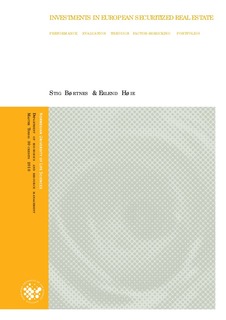| dc.description.abstract | This thesis applies factor models in explaining common variations in returns within the European
securitized real estate sector. The three risk factors suggested by Fama & French (1993), the
market, size and B/M ratio, have become known as a state-of-the art framework for various
applications within the financial research. We explore these factors in a three-factor model before
we include two additional factors, liquidity and momentum into a five-factor model. We
investigate how the factors explain common variations in returns within the securitized real estate
sector in Europe from 2000 to 2009. The models are explored on portfolios both categorized by
firm characteristics and country of origin.
Surprisingly, we find that on average, big companies significantly outperform small companies.
Contradicting previous asset pricing literature, we find that big companies can expect higher
average returns. We suggest two possible explanations for the higher average returns. One, there
exists a higher risk premium in big-capitalized companies. Two, by holding stocks from bigcapitalized
companies, an investor can yield higher returns without being exposed to higher risk,
and thus, an arbitrary opportunity may exist.
However, as expected, there exists a significant value premium, value stocks outperform growth
stocks. This premium accounts for 14.5 % annually, being significant at the 5 % level. Thus, as
expected and in line with previous findings, high book-to-market equity companies carry a risk
premium, providing opportunities for the mean-variance efficient investor.
The three-factor model by Fama & French (1993) provides an informal description of the crosssectional
variation in returns in the investigated sector, where the model yields robust results for
the European securitized real estate markets during the first decade of the millennium. Compared
to the traditional capital asset pricing model (CAPM), the three-factor model yields higher
explanatory power in all portfolios investigated, where all slopes except one being significant at
the 5 % level.
The five-factor model includes two additional factors, namely liquidity and momentum. This
model provides relatively vague results. Even though both factors provide positive premiums,
neither show significance, which we address as the reason for the spurious results. Finally, an
international six-factor model developed by Griffin (2002) is implemented. The model yields
highest significant explanatory power for Belgian real estate stocks. This result suggests that
Belgian real estate companies’ returns are most integrated to the rest of the world. Caution,
however, needs to be taken, as the economic implementation of this result is a troublesome
business. | en_US |
